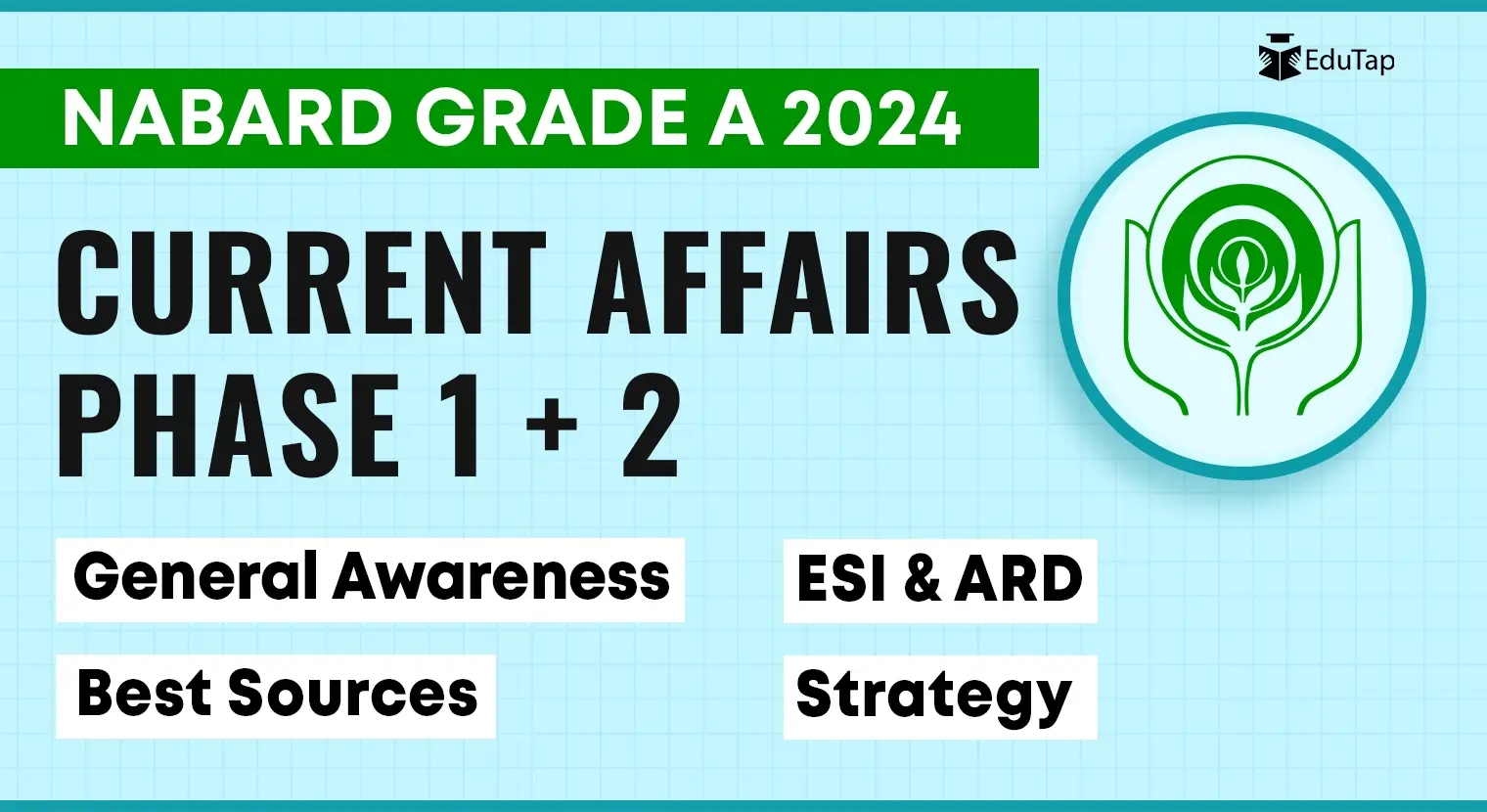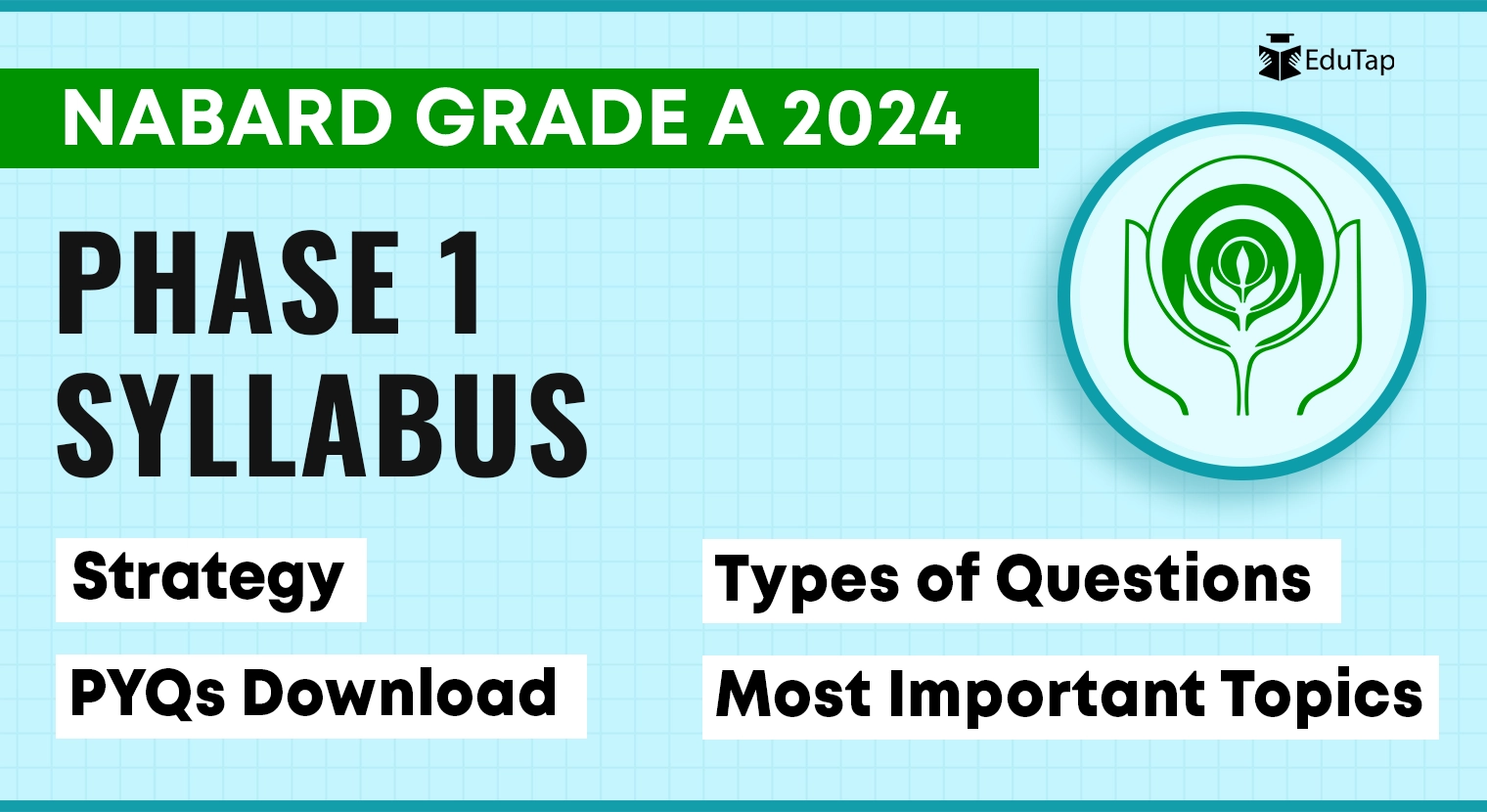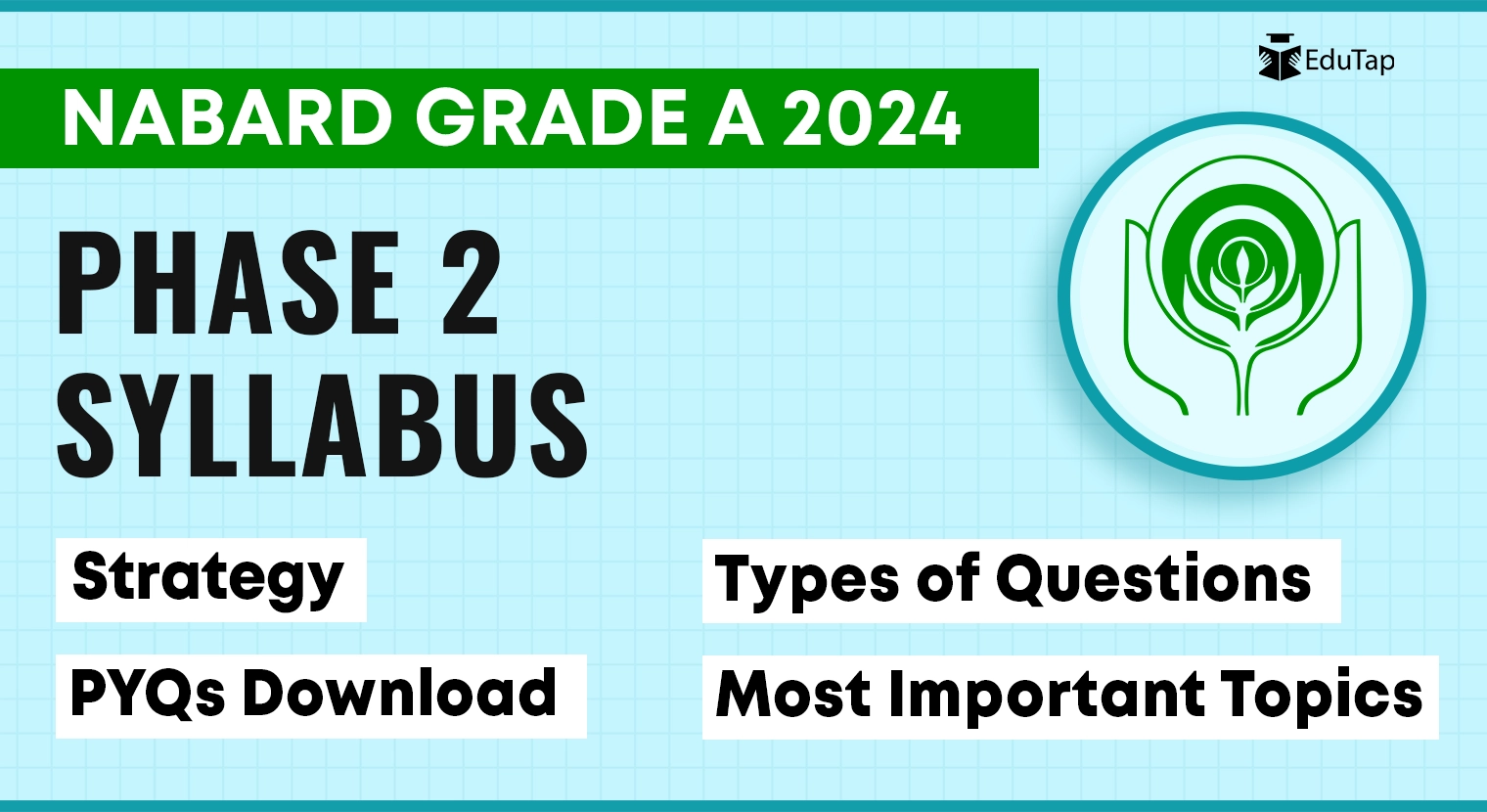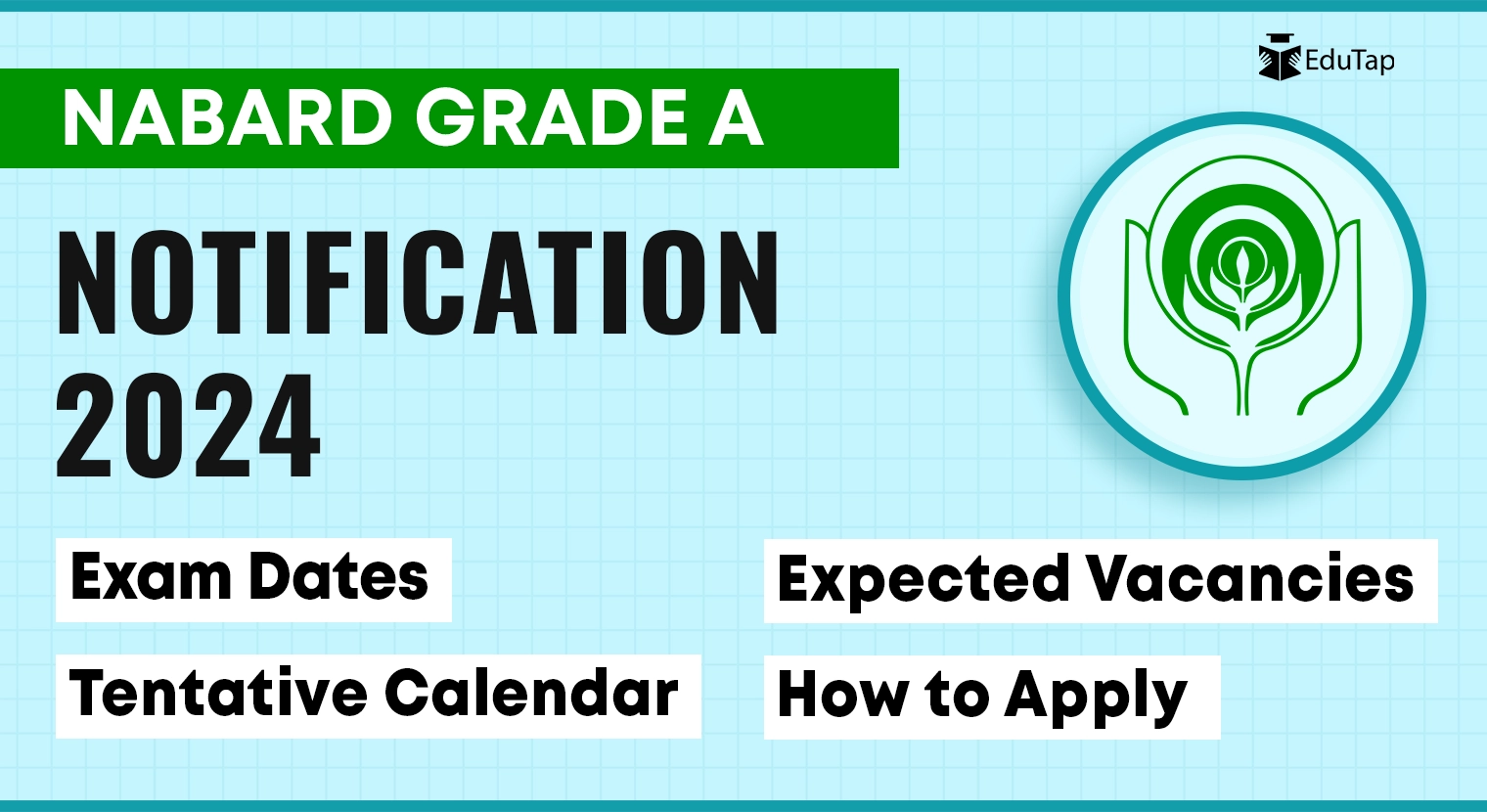Current Affairs, as a component, plays a critical role in phase 1 as well as 2 of the NABARD Grade A exam. However, for an aspirant like you, navigating the sheer volume of news and daily newspaper articles can be overwhelming. Questions like “When should I start preparing current affairs?”, “What sources are reliable?”, “How far back should I cover?”, and “How can I retain information?” are likely to overwhelm any sincere aspirant.
This article addresses these concerns and provides a comprehensive roadmap to conquer Current Affairs for General Awareness, ESI and ARD. We’ll provide the decoded syllabus, explore the types of questions you can expect, examine the most effective preparation strategy, and recommend valuable resources to ensure you’re fully prepared.
General Awareness (GA) Current Affairs
General Awareness is a merit section in Phase 1 carrying 20 questions of 1 mark each.
GA Current Affairs: Syllabus Phase 1
Based on an in-depth PYQ analysis of frequently asked questions, the following is the decoded syllabus for GA Current Affairs that you must study for NABARD Grade A 2024 exam.
- Current Affairs of the preceding 6 months from the date of examination
- National News: MoUs, summits, and major events related to India.
- International: Summits and conferences held abroad.
- Defence: Military exercises, drills, and major updates related to the defence sector of India.
- Days in News: Major events or days, along with its date, and theme.
- Persons in News: Obituaries, appointments, retirements
- Sports: Major tournaments and their winners.
- Science, Technology, and Space
- Awards and honours
- Environment
- Banking, Economy, and Schemes
- Books and Authors
- Static GA: Chief Ministers and Cabinet Ministers, National Parks and Sanctuaries, Organisations’ Headquarters, Banks’ Headquarters and Taglines, Power Plants in India, Indian Dance Forms, Countries’ Capitals and their Currencies.
GA Current Affairs: Types of Questions
Following is a 5-year breakdown of the number of Current Affairs questions asked to help you understand the weightage given to Current Affairs in General Awareness. Understanding this breakdown is important because the GA component is made up of static GK as well as current affairs.
| GA | 2023 | 2022 | 2021 | 2020 | 2019 |
| Total Questions | 20 | 20 | 20 | 20 | 20 |
| Current Affairs Questions | 15 | 17 | 17 | 18 | 18 |
Let us now look at the type of questions asked in the GA current affairs section of the NABARD Grade A 2023 Phase 1 exam and their difficulty level.
| S.No. | Question | Level |
| 1 | Recently, the Russian Federation allowed Indian passport holders an electronic visa (e-Visa) facility from 1 August 2023, which is valid for 60 days, allowing tourists to stay in Russia for how many days per visit? | Difficult |
| 2 | Central Railway’s New Amravati station has engraved its place in history as the third station within the Central Railway to be designated a “Pink Station”. Where is the headquarters of the Central Railway Zone of Indian Railways? | Moderate |
| 3 | Recently, the Bureau of Indian Standards, the National Standards Body of India signed a Memorandum of Understanding (MoU) with 35 prestigious institutions across the country to foster collaboration in standardisation and conformity assessment. These MoUs aim at? a. Standardisation in Curricula in Academics b. Empowering these Institutions for Hallmarking and Laboratory services for the benefit of the Jewellery Industry c. Fostering collaboration in standardisation in conformity assessment standardisation. | Difficult |
| 4 | Which of the following are expected benefits of the National Green Hydrogen Mission? | Easy |
Key Takeaways
- When preparing for Current Affairs, it is important to go beyond just reading headlines and delve deeper into the context and implications of recent events to effectively tackle difficult questions.
- There has been a trend of application-based questions for Current Affairs coverage. This means that you should not just memorise facts but learn to analyse and apply your knowledge to solve problems and predict future trends.
Economic and Social Issues (ESI) Current Affairs
The Phase 1 ESI section presents candidates with 40 questions of 1 mark each. Phase 2 however is a combined paper of ESI & ARD carrying a total of 100 marks (50 marks for objective MCQs + 50 marks for descriptive answer writing).
ESI Current Affairs: Syllabus Phase 1 + 2
Based on an in-depth PYQ analysis of frequently asked questions, the following is the decoded syllabus for ESI Current Affairs that you must study for NABARD Grade A 2024 exam.
- Flagship Economic Development Schemes: PM-SYM, PMJDY, PMJJBY, PMSBY, PMMY, Stand Up India, DDU-GKY, PMEGP, Production-Linked Incentive (PLI) Scheme
- Reports: Economic Survey, Union Budget, Census, SECC (latest version)
- Data by Important Institutes: NITI Ayog, RBI, NABARD, WTO, WB, IMF, ADB, etc (latest version)
- MoUs + Funding, Banks, Alliance, Membership
- Ranking: India and the Indian States
- First in News (For ex: an initiative taken for the first time, a national organisation’s first event, etc.)
- Current Affairs related to ESI Static topics: Economics (such as GDP), Growth Projections, Monetary and Fiscal Policy (Repo Rates), and Social Issues (such as meetings related to Poverty, Gender Bias, Human Development, Education, and Health)
ESI Current Affairs: Types of Questions
Following is a 5-year breakdown of the number of Current Affairs questions asked to help you understand the weightage given to Current Affairs in Economic and Social Issues.
| Subject | 2023 | 2022 | 2021 | 2020 | 2019 |
| Total Questions | 40 | 40 | 40 | 40 | 40 |
| Current Affairs Questions | 35 | 37 | 28 | 34 | 39 |
Let us now look at the type of questions asked in the ESI section (current affairs) of NABARD Grade A 2023 Phase 1 exam and their difficulty level.
| S.No. | Question | Level |
| 1 | Under the DAY-NRLM scheme, the households are identified with a minimum 1 deprivation criterion per the Socio-Economic and Caste Census (SECC), along with households identified through Participatory Identification of the Poor (PIP) to be eligible. Which of the following verifies the list prepared under PIP? | Moderate |
| 2 | As per the RTI Act, Central Public Information Officers/ State Public Information Officers (under Section 6) shall dispose of the case in a maximum of ______ days, as per Sections 8 and 9. | Difficult |
| 3 | Under the PM Vishwakarma Yojana, the beneficiaries will be given a toolkit incentive along with the initial collateral-free ‘Enterprise Development Loan’ of up to a maximum of ________ repayable in _______. | Easy |
| 4 | Which of the following is not an automatic/compulsory inclusion under Pradhan Mantri Awas Yojana (Gramin)? | Difficult |
Key Takeaways
- Current Affairs carry a significant weightage in ESI, as compared to the static portion.
- Current Affairs tests your in-depth knowledge of government initiatives and reports. Simply reading and cramming headlines won’t suffice. Aspirants are advised to thoroughly understand the application and implications of the schemes and reports.
- Aspirants should also be prepared for 1-2 questions on reports released up to 12 months before the exam date by international and national organisations related to the syllabus.
Agriculture and Rural Development (ARD) Current Affairs
The ARD Phase 1 section presents candidates with 40 questions of 1 mark each. Phase 2 however is a combined paper of ESI & ARD carrying a total of 100 marks (50 marks for objective MCQs + 50 marks for descriptive answer writing).
ARD Current Affairs: Syllabus Phase 1 + 2
Based on an in-depth PYQ analysis of frequently asked questions, the following is the decoded syllabus for ARD Current Affairs that you must study for NABARD Grade A 2024 exam.
- ARD Schemes of the last 6 months (preceding the exam date)
- Flagship Agriculture Schemes: AIF, PMKSY, PMFBY, PM-KMY, e-NAM, KCC, SHC, PMMSY, NHM
- Flagship Rural Development Schemes: PMAY-G, PMGSY, NRuM, MGNREGA, JJM, NRLM, DDUGKY
- Census: 2011, SECC, Livestock, Handloom, Agriculture
- Annual Reports: MoA&FW, AH&D, NABARD, MoRD, and MSP
- Latest Reports: NAFIS Survey, Agricultural Marketing and Farmer Friendly Reforms Index (AMFFRI), etc.
- Latest Union Budget
- Latest Economic Survey
- Indian State of Forest Report
- Key Stats of Cooperative Banks
ARD Current Affairs: Types of Questions
Following is a 5-year breakdown of the number of Current Affairs questions asked to help you understand the weightage given to Current Affairs in Agriculture and Rural Development.
| Subject | 2023 | 2022 | 2021 | 2020 | 2019 |
| Total Questions | 40 | 40 | 40 | 40 | 40 |
| Current Affairs Questions | 10 | 9 | 17 | 20 | 17 |
Let us now look at the type of questions asked in the ARD section (current affairs) of the NABARD Grade A 2023 Phase 1 exam and their difficulty level.
| S.No. | Question | Level |
| 1 | The threshold yield for a crop in a notified insurance unit is the average yield of the past seven years (excluding calamity year(s) as notified by State Government/UT) multiplied by the applicable ___________ for that crop in PMFBY. | Difficult |
| 2 | The central government provides additional ______ of work in drought-hit areas under the MGNREGA scheme to provide relief to farmers in view of the deficit monsoon in various parts of the country. | Difficult |
| 3 | DAY-NRLM has a provision for interest subvention, to cover the difference between the Lending Rate of the banks and 7% on all credit from the banks/ financial institutions availed by women SHGs, for a maximum of ________ per SHG. | Difficult |
| 4 | SBM(G) Phase-II will be implemented from 2020-21 to _______ in a mission mode. | Difficult |
Key Takeaways
- The weightage given to Current Affairs in ARD is less, compared to ESI Current Affairs. However, it is still important and should not be skipped.
- In 2023, a significant portion of the ARD Current Affairs questions relied heavily on data, estimates, and figures relating to schemes, reports, and indices, making the paper difficult. Aspirants are advised to be prepared to tackle such questions.
- While studying old schemes and their recent updates (if any) is important, you should not overlook newer schemes. Ensure you’re familiar with their key features and objectives.
The ESI and ARD analysis provided above focuses specifically on questions from Phase 1 of the NABARD Grade A 2023 exam. It’s important to note that Phase 2 features a combined paper for ESI and ARD, where 30 questions (a total of 50 marks) are presented. While some questions carry 1 mark each, others are of 2 marks.
Nevertheless, the syllabus for Phase 1 and 2 for ESI and ARD is the same. As a result, the objective questions (MCQs) asked are generally the same, with varying difficulty levels of moderate to difficult.
Let’s briefly examine the descriptive questions of the NABARD Grade A Phase 2 examination.
ARD + ESI Phase 2 Current Affairs: Descriptive Questions
The NABARD Grade A 2023 Phase 2 exam heavily included questions from the static portion of the syllabus on ESI and ARD.
However, this doesn’t mean current affairs are never tested. Here are two questions based on current events, direct and indirect, from the NABARD Grade A 2022 Phase 2 exam for ARD and ESI (Paper 2) respectively.
| S.No. | Question | Subject | Level |
| 1 | Discuss the objectives of Pradhan Mantri Matsya Sampada Yojana (PMMSY). Also, highlight the important initiatives under this scheme (15 marks, 600 words) | ARD | Easy |
| 2 | Investment in Social Infrastructure is a prerequisite for Inclusive Growth.” Discuss this in Indian Context. (15 marks, 600 words) | ESI | Moderate |
Key Takeaways
The NABARD Grade A Phase 2 2022 exam had two questions: one about a specific scheme (ARD) and another about a broader concept (ESI).
To answer the second question, you need to explain the concept of Inclusive Growth, its elements like skill development, and its different dimensions. But, it would be best if you also mentioned various social sector programs launched by the Indian government as examples to support your answer better, such as;
- Pradhan Mantri Vaya Vandana Yojana, 2018
- National Nutrition Mission (POSHAN Abhiyaan)
- Mission Indradhanush (MI) and Intensified Mission Indradhanush (IMI)
- Samagra Shiksha
- ICT Driven Initiatives
- Skilling Ecosystem Rural Infrastructure
- Rural Infrastructure
- Financial Inclusion
Hence, candidates need to have a strong foundation of both the static and current affairs syllabus to effectively approach and crack the NABARD Grade A Phase 2 exam.
Now that you have understood the current affairs syllabus and types of questions to prepare for the NABARD Grade 2024 exam, let’s examine the do’s and don’t of your preparation strategy.
NABARD Grade A 2024: Current Affairs Strategy
In the past, remembering Current Affairs facts like dates and names related to schemes or reports was crucial to cracking the NABARD Grade A exam. But now, you need to understand the news in-depth and develop an opinion.
For example, it’s not enough to know when a scheme was announced. You also need to know if it changed recently, how it affects people’s lives, what are the goals for the future, and the positive or negative impact it can have on society.
Phase 1 Current Affairs Preparation Strategy
Your main focus should be on the last 6 Months preceding the exam date.
- Do’s
- Analyze PYQs
- Make brief, concise notes and incorporate consistent revision
- Practice via MCQs/Mock Tests
- Analyse your mistakes and learn from them
- Don’ts
- Don’t rely solely on newspapers
- Don’t cram full documents of Union Budget and Economic Survey
- Avoid UPSC-oriented Current Affairs magazines
Phase 2 Current Affairs Preparation Strategy
Your main focus should be on the last 8 Months preceding the exam date, i.e., about 7 months preceding the Phase 1 exam date plus the approximate one month leading up to Phase 2.
- Do’s
- Revise and strengthen your Phase 1 preparation
- Deepen your understanding of key topics and events, their objectives, and implications
- Practise descriptive answer writing for ESI and ARD topics incorporating studied current events as substantial examples; this will help you strengthen your ESI and ARD preparation as well as retain covered information
- Don’ts
- Don’t neglect Phase 1 notes; follow a put-together integrated preparation
- Don’t focus entirely on new topics at this stage, prioritise revision and retention of information
Remember, consistent effort and smart preparation are key to mastering Current Affairs for both Phase 1 & 2 of the NABARD Grade A exam.
Now that you have a preparation strategy in place, let’s look at the resources you need to prepare for the Current Affairs of Phases 1 and 2 of the NABARD Grade A 2024 examination.
NABARD Grade A Current Affairs Sources
Following is our topper’s recommended list of resources to follow for NABARD Grade A 2024 Current Affairs preparation.
EduTap’s Resources: NABARD Grade A 2024 Current Affairs
The following Current Affairs resources are part of the EduTap NABARD Grade A 2024 preparation courses.
- CurrentTap (GA + ESI + Finance): Covers relevant national and international news, including topics crucial for the GA, ESI, and Finance sections. The Finance section covers NABARD questions relevant to topics such as the Banking System, RBI, etc.
- CurrentTap (Agriculture): Even though the weightage of current affairs in ARD is lower, this dedicated resource ensures you don’t overlook crucial developments.
- SchemesTap: Stay informed with detailed explanations of important government schemes, ensuring you’re familiar with their objectives and implications.
- ReportsTap: Access to critical reports and indices published by national and international organisations, broadening your knowledge base on topics relevant to the syllabus.
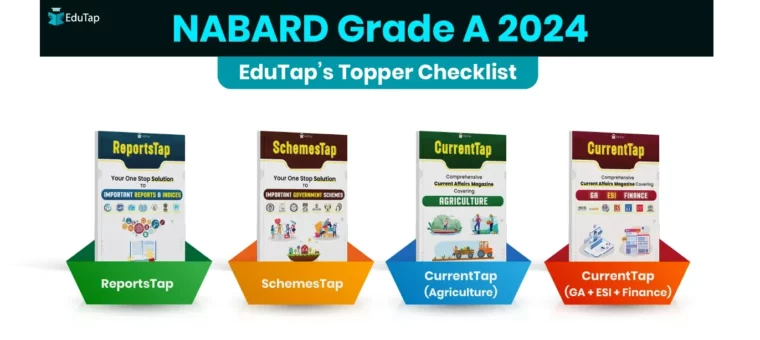
EduTap Free Study Material
Following is a list of EduTap’s YouTube playlists beneficial for comprehensive coverage of Current Affairs.
| S.No. | Current Affairs Topic (Phase 1 + 2) | Link |
| 1 | NABARD GA + ESI Current Affairs | Watch Now |
| 3 | NABARD ARD Current Affairs | Watch Now |
| 3 | NABARD Government Schemes | Watch Now |
| 4 | NABARD Finance Current Affairs | Watch Now |
Benefits of Using EduTap’s Current Affairs Resources
- Avoid wasting time searching through multiple sources and have access to well-structured content.
- Benefit from expert analysis and contextual information.
- Maximise your Current Affairs preparation with relevant and in-depth knowledge.
Next, for students focusing on self-study, the Press Information Bureau (PIB) website and The Hindu newspaper are two reliable sources to follow.
Press Information Bureau (PIB): Current Affairs
The Press Information Bureau (PIB) is a valuable resource for covering Current Affairs relevant to the NABARD Grade A 2024 exam. Here’s a concise guide on how to tackle it effectively.
How Many Months Do You Need to Cover?
- Phase 1: Ideally, cover the last 6 months of PIB news. If short on time, focus on the 3 months preceding the exam date.
- Phase 2: Aim for 8 months of news before the exam date. Cover at least 6 months if time is tight. Focus on information retention and not cramming everything.
Which News Should You Cover?
- Visit the official PIB website: https://pib.gov.in/. Click the “Press Release” tab. Select “All Releases”.
- Focus on press releases of:
- Ministries and government organisations: These are directly relevant to the NABARD Grade A syllabus, especially ESI (Economics & Social Issues) and ARD (Agriculture & Rural Development). For example, the Ministry of Agriculture and Farmers Welfare and the Ministry of Fisheries, Animal Husbandry, and Dairying.
- Schemes and programs launched by the government: These are crucial for ESI and ARD sections.
What to Cover Within Each News Item?
- Headline: Quickly grasp the key information.
- Date: Track the timeline of events; from oldest to the most recent update.
- Ministry/organisation/individual involved: Identify the relevant department, or institution, along with important names (if any).
- Background information and context: Understand the issue at hand, and focus on ‘why’ is important.
- Key points and announcements: Extract the crucial details about the updates and their implications.
- Future plans and impact: Analyse the potential consequences and significance.
The Hindu: Current Affairs
The Hindu newspaper is highly recommended for NABARD Grade A Current Affairs preparation because of its thorough coverage of current events.
- Reading editorials promotes individual analytical skills and encourages you to critically evaluate different perspectives on current events, a crucial skill for the exam’s descriptive paper.
- The Hindu’s sister publication, BusinessLine, for example, offers comprehensive coverage of economic and financial news, catering to the NABARD Grade A syllabus.
- The Hindu is known for its high-quality journalism and insightful writing style, enhancing your vocabulary and improving your writing skills.
How to Make the Most of the Hindu
- Read Every Day: Make it a habit to read The Hindu every day, paying particular attention to the BusinessLine and editorials.
- Take Notes: Jot down brief notes that highlight the main ideas and points made throughout the articles.
- Analyse and Connect: Consider what you’ve read, then make connections between it and other topics from your ESI and ARD exam syllabus. This will help you enhance your answer-writing skills as well.
By following the recommended resources, you can effectively cover Current Affairs and gain a significant advantage in your NABARD Grade A 2024 preparation.
Conclusion
This article has answered all your questions surrounding Current Affairs preparation for the NABARD Grade A 2024 exam. We’ve explored the types of questions you can expect, provided the decoded syllabus and a comprehensive preparation strategy, and recommended invaluable resources.
Remember, consistent effort and a strategic approach are key to unlocking your full potential in this crucial section. Now, go ahead and crack the NABARD Grade A exam with your expertise in Current Affairs.
FAQs
The official notification for NABARD Grade A 2024 is expected to be released in August or September 2024. Aspirants can stay updated by regularly checking the NABARD website.
The syllabus for Current Affairs covers three subjects; i.e., General Awareness, Economic and Social Issues, and Agriculture and Rural Development. The syllabus for this includes government schemes, reports and indices, policies, agricultural and economic developments, and other social issues. It’s crucial to focus on the latest 6 months for Phase 1 and 8 months for Phase 2 (preceding the exam date).
Yes, EduTap’s resources are sufficient to build a strong foundation for NABARD Grade A Current Affairs preparation. They comprehensively cover the information you would find in resources like PIB and The Hindu, offering a concise and structured approach. Additionally, EduTap’s resources provide insightful analysis and contextual information, helping you gain a deeper understanding.
